Being an avid fish keeper, I have been captivated by the Oscar Fish, scientifically known as Astronotus ocellatus, for years. This member of the Cichlidae family hails from the slow-moving rivers and streams of South America. Known for their distinctive colors and dynamic personalities, they’ve made a name for themselves in the world of aquarium hobbyists. With varying hues from vibrant reds and bright oranges, to classic blacks and grays, their diverse color palette truly makes them a sight to behold.
Interestingly, Oscar Fish isn’t rare in the slightest. You might think that such a uniquely colored, intelligent creature would be hard to come by, but that’s not the case. These fishes are quite popular, and you can often find them in the homes of fish enthusiasts worldwide.
The Oscar Fish is often regarded as one of the most interactive and personable freshwater fish you can own. Their personality sets them apart. You’ll often see them showing off their playful side, rearranging rocks, and items in their tank for fun. These fishes have even been known to recognize their owners, a testament to their intelligence and memory.
Speaking of color, there are a variety of Oscar Fish to choose from. You’ve got your Tiger Oscars, known for their bright orange and contrasting dark black patterns. There are Red Oscars, appreciated for their vibrant red coloration. Let’s not forget the Albino Oscars, a genetic variant that lacks melanin. Lastly, we have the Veil-tail Oscars, a less common variant with elongated, trailing fins.
Despite their size – they can grow up to 12-18 inches – Oscar Fish are generally bottom to mid-water dwellers. They prefer their homes to have a sandy bottom with plenty of covers in the form of rocks or driftwood. As for their diet, while they’re omnivores, their preferences lean more towards the carnivorous side of things. They’re not picky eaters and enjoy a balanced diet of high-quality commercial fish food, shrimp, worms, and even bits of fruits and veggies.
You might find it surprising, but Oscar Fish can live up to 10-15 years with proper care! This means you’ll need a tank that’s at least 55 gallons for one Oscar, but remember, the bigger, the better.
Oscar Fish are known for their territorial behavior, particularly during feeding and breeding. It’s just one of the many ways they express their unique personalities. It’s why Oscar Fish are often called “water dogs”. They’re engaging, fun, and quite the handful, but undeniably worth the effort!
In this article, we’ll delve further into the Oscar Fish, tackling their complete care guide, ideal tank mates, and common FAQs. With this comprehensive resource, you’ll be well-equipped to make the most of your Oscar Fish-keeping journey. So, stay tuned and get ready to dive deep into the exciting world of Oscar Fish.
Table of Contents
Understanding Oscar Fish: Price, Common Names, and Variants
When it comes to the world of aquatics, the Oscar Fish, scientifically known as Astronotus ocellatus, is a well-regarded member. Belonging to the Cichlidae family, these fish are most commonly referred to as Oscar Fish, but they’re also known by other names such as velvet cichlid or marble cichlid.
Let’s take a look at the price of Oscar Fish. Depending on the size, color, and variant, a single Oscar Fish can cost anywhere from $10 to $100. Young Oscars, about an inch or two in size, can usually be bought for around $10 to $20. As the fish grow larger and showcase more distinct coloration, the price can increase substantially. More exotic or rarer variants of the fish like the Long Fin Oscar can fetch higher prices, sometimes reaching the $100 mark.
There are several popular variants of Oscar Fish, each with its unique appeal and coloration. Here are some of the most common ones:
Tiger Oscar
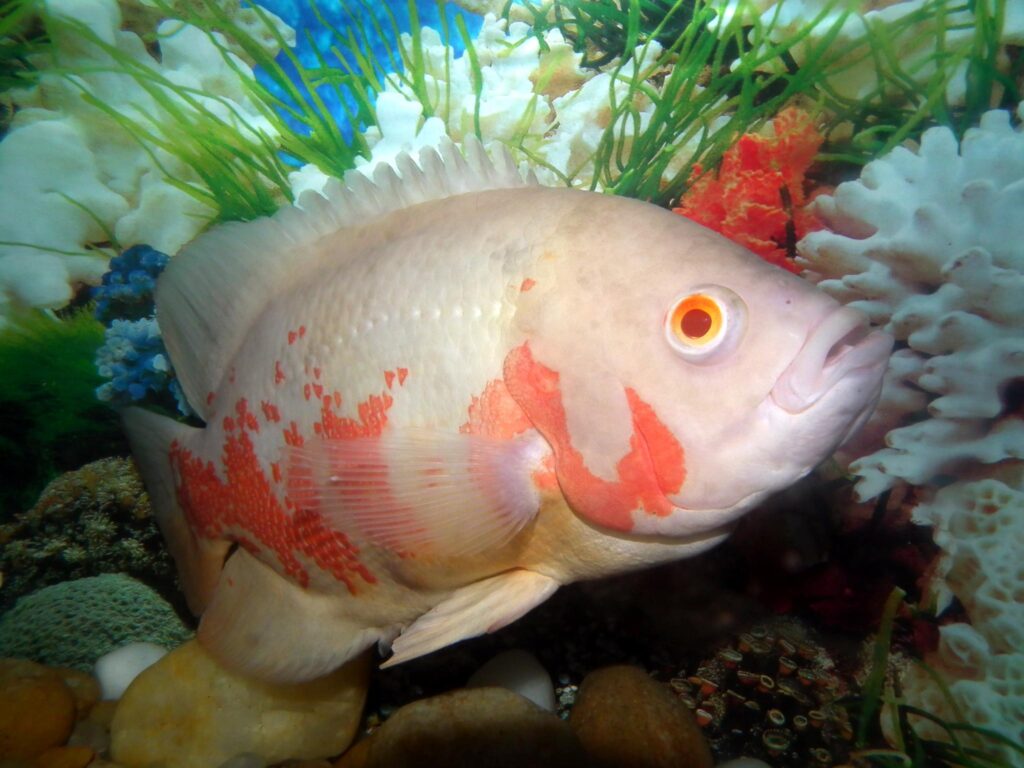
This variant is distinguished by a bright orange and black pattern that resembles the stripes of a tiger. Tiger Oscars are among the most common Oscar variants and are widely available in pet stores.
Red Oscar
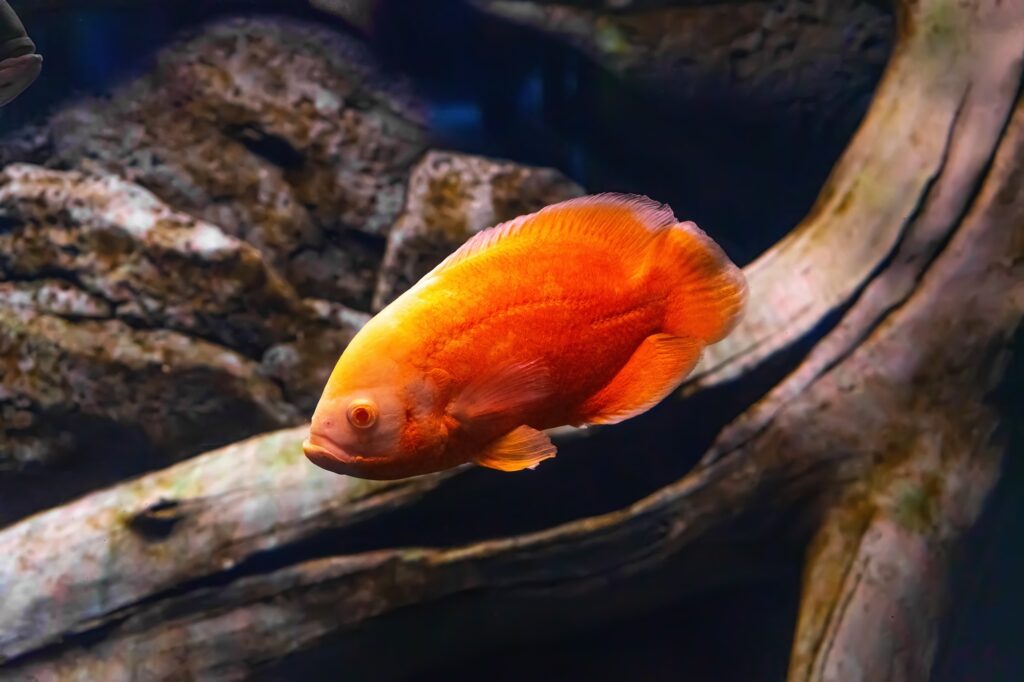
The Red Oscar boasts a vibrant red-orange body. While similar in pattern to the Tiger Oscar, their primary color leans more towards red, hence the name. They are a popular choice for hobbyists who want a splash of color in their tank.
Albino Oscar
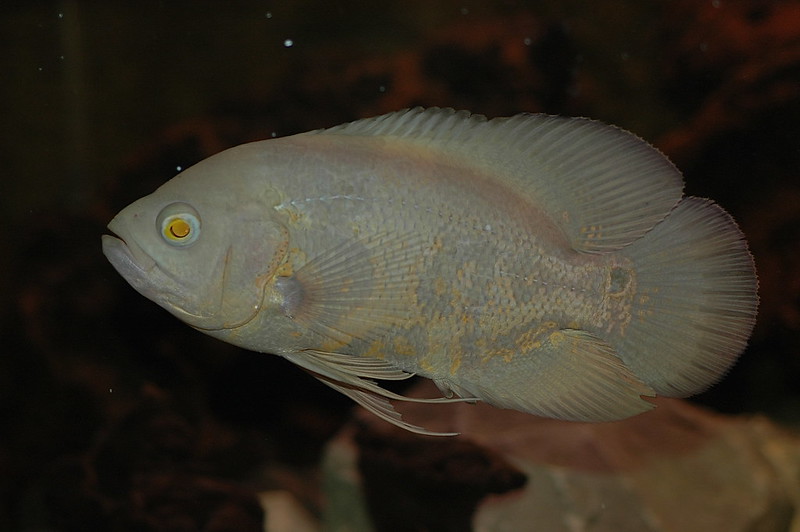
The Albino Oscar is a genetic variant of the Oscar Fish that lacks the pigment melanin. This gives them a unique pale or white appearance, often accompanied by red or pink eyes. They provide a stark contrast to other darker-colored Oscar variants and stand out in any aquarium.
Veil-tail Oscar
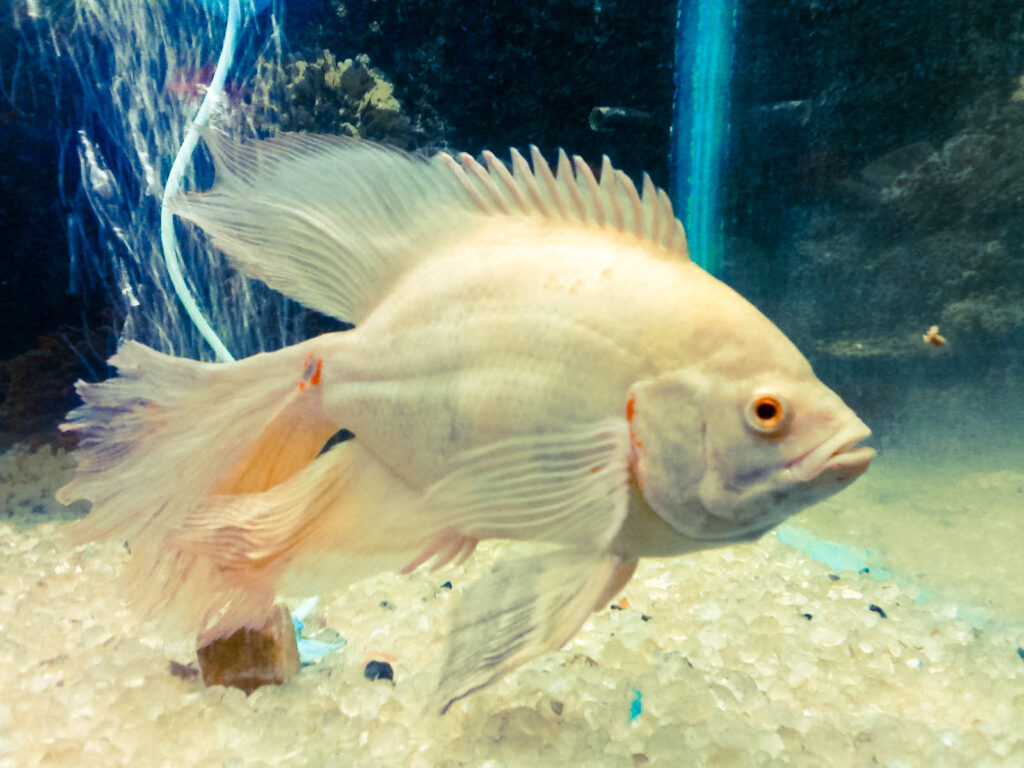
Veil-tail Oscars are less common than the other variants. They are characterized by their elongated, trailing fins, which make them a unique addition to any tank.
Lutino Oscar
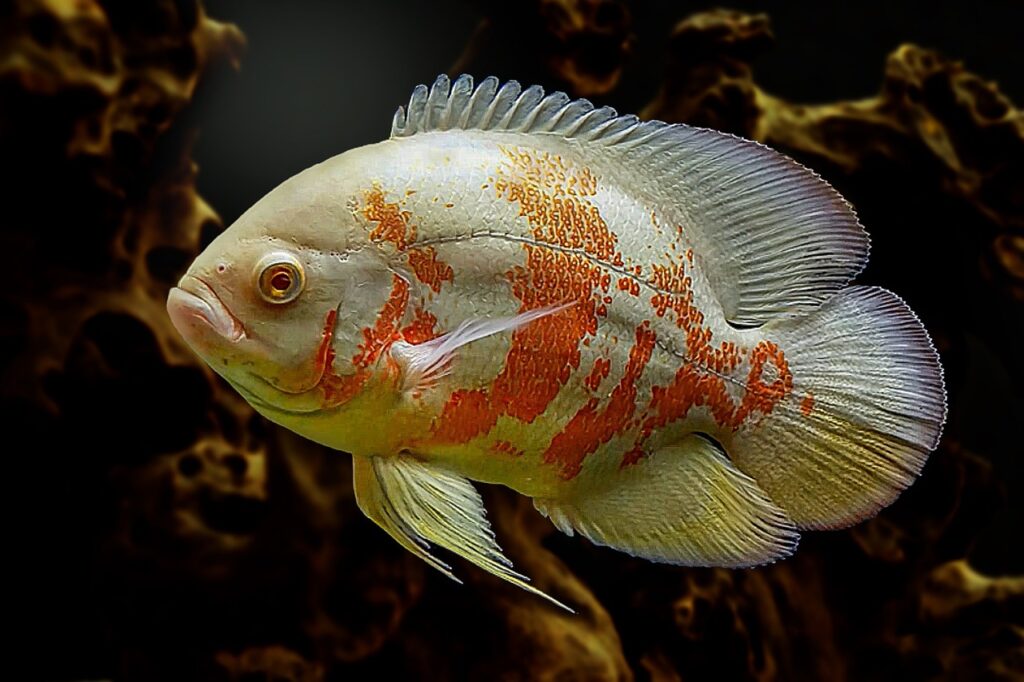
A variant of the Albino Oscar, the Lutino Oscar also lacks dark pigmentation. However, they possess a yellowish coloration, unlike the pale white of Albinos. Their bright yellow bodies with a hint of red around the eyes and gills make them a vibrant addition to the aquarium.
Blue Oscar
This variant is not common and is believed to be a color morph of the original Oscar fish. The Blue Oscar shows a silvery-blue coloration with a hint of gray, giving it a somewhat metallic appearance.
Black Oscar
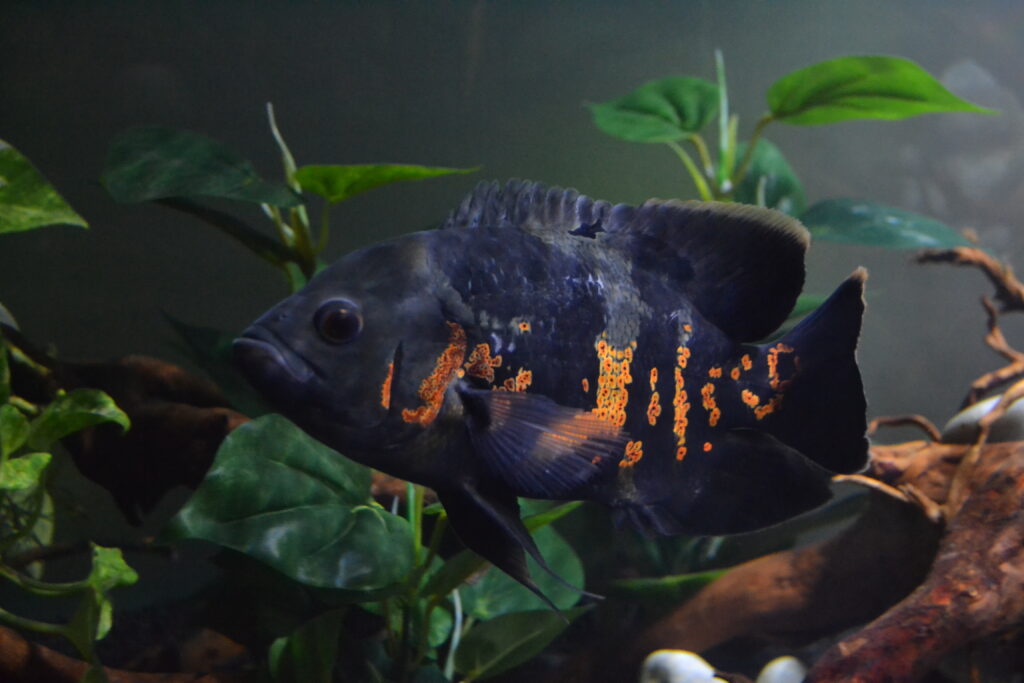
This variant is dark and usually black all over. While their color might seem less striking, their deep black tone adds a sense of drama and contrast to an aquarium.
Lemon Oscar
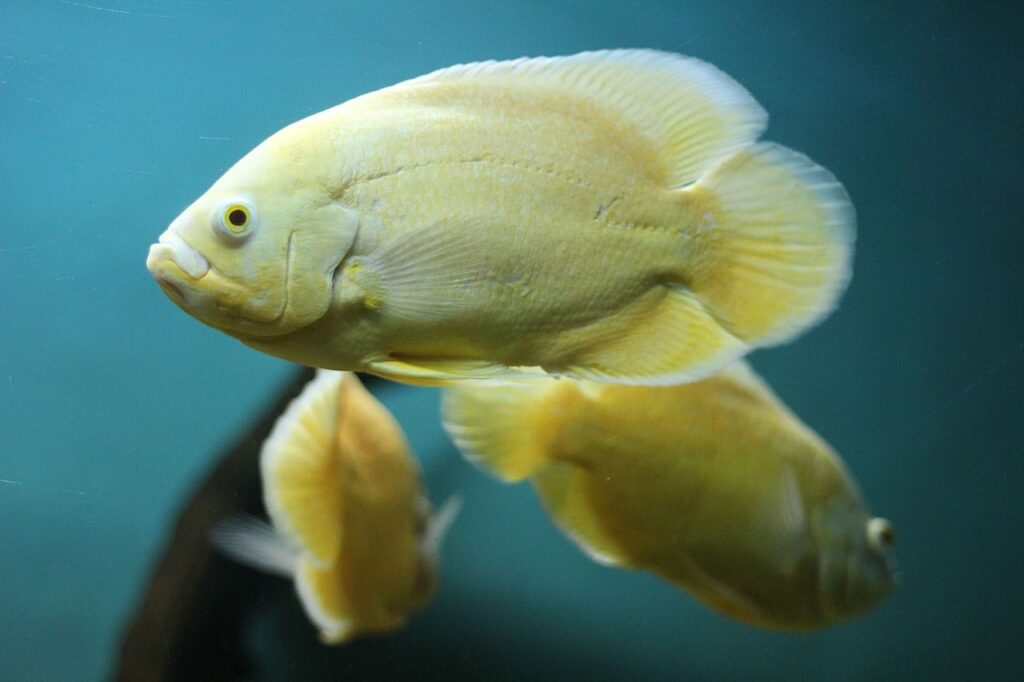
This is a rarer variant of Oscar Fish. Lemon Oscars have a yellowish-white body with a hint of light orange on the fins. Their light coloration offers a refreshing visual contrast in the tank.
Wild Type Oscar
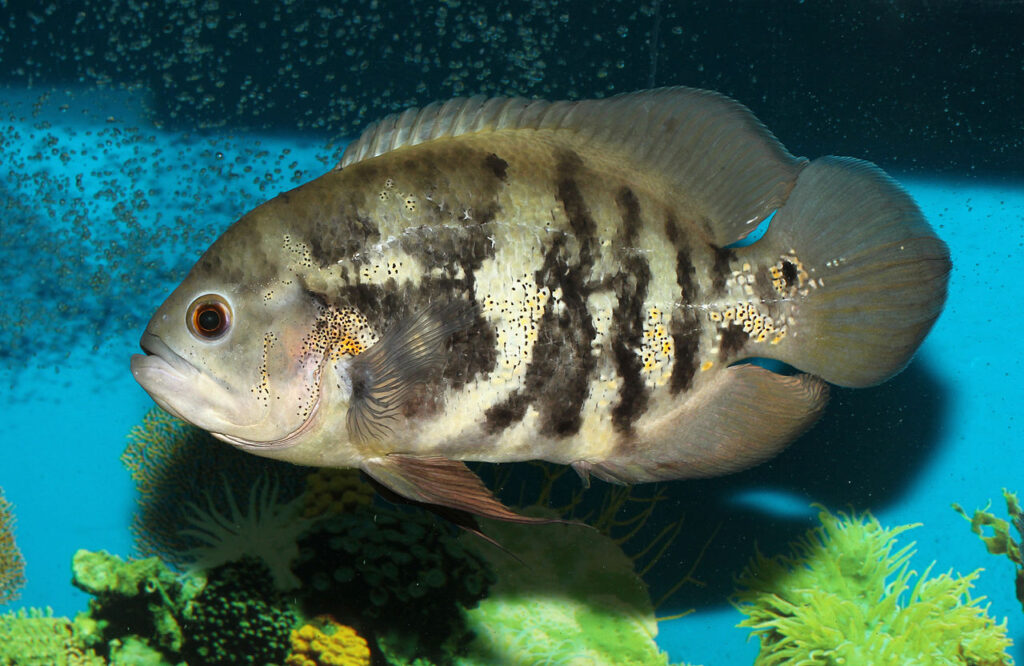
The Wild Type Oscar is the most representative of the species found in their natural South American habitats. They typically have a dark base color, usually dark gray or black, with an array of orange, red, or yellow markings.
Piebald Oscar
The Piebald Oscar has a distinctive pattern of pigmented spots on an unpigmented background. This variant is not as common as others, but their unusual color pattern makes them quite striking in an aquarium.
Regardless of the variant you choose, all Oscar Fish require the same level of care, diet, and suitable tank conditions. Each of these variants offers its own unique charm and can bring a distinctive appeal to your aquarium.
Understanding the different variants and what influences the price of Oscar Fish is a great starting point for any potential Oscar Fish owner. It’s always best to choose a variant that suits your aesthetic preference and budget.
Ideal Aquarium Conditions: Tank Size and Water Parameters
Creating the perfect home for your Oscar Fish is crucial for their well-being and overall health. One of the first things to consider is the size of the tank. As Oscar Fish can grow quite large – up to 12-18 inches in length – they require a spacious environment to thrive. A single Oscar Fish will need a minimum tank size of 55 gallons, but larger is always better. If you plan to keep more than one Oscar, you’ll need to increase the tank size accordingly to provide enough space for each fish.
Tank placement also plays a role in your Oscar Fish’s comfort. These fish don’t appreciate too much noise or disturbance, so it’s best to position the tank in a quieter part of your home.
Water quality is another crucial factor in maintaining an ideal environment for your Oscar Fish. These fish prefer a pH range between 6.0 and 8.0, with the ideal being around 7.0 – a neutral pH. Regular testing of your tank’s water is recommended to ensure that it stays within these parameters.
The water hardness should ideally be between 5 and 20 dGH, and the water temperature should be maintained between 74°F (23°C) and 81°F (27°C).
Oscar Fish are quite messy eaters, so strong filtration is essential. A filter with a rating suitable for your tank’s size will help keep the water clean and free from debris. Moreover, a good filtration system will also help to maintain stable water parameters, which is beneficial to the overall health of your Oscar Fish.
The nitrogen cycle should be well established before introducing an Oscar to your tank. Ammonia and nitrite levels should be zero, while nitrate levels should be kept as low as possible, preferably below 20 ppm. Regular water changes – typically 10-20% of the tank volume per week – can also help control nitrate levels and keep the water fresh and clean.
In terms of tank decoration, Oscars appreciate a habitat that resembles their natural environment. This means a sandy or fine gravel substrate and plenty of hiding places in the form of rocks or driftwood. However, Oscars are known for rearranging their surroundings, so make sure that any decorations are secure and won’t harm your fish if moved.
Plants can also be included, but choose sturdy varieties, as Oscars might uproot more delicate ones. Keep in mind that Oscars are powerful swimmers and require plenty of open space to swim around. Too many decorations could make the tank feel cramped and stress your fish.
The Life of Oscar Fish: Lifespan and Full Size
The Oscar Fish, or Astronotus ocellatus, is a captivating addition to an aquarium due to its vibrant coloration and intriguing behavior. But another aspect of Oscar Fish that makes them so appealing to many aquarists is their impressive size and considerable lifespan.
Oscar Fish can grow to be quite large, reaching a full size of 12 to 18 inches in length. This substantial size is one of the reasons these fish require a spacious environment to thrive. When you introduce an Oscar to your aquarium, keep in mind that the tiny fish you bring home will not remain that way for long. They grow relatively fast, reaching their full size within a year to a year and a half.
Oscar Fish also have a relatively long lifespan, particularly when compared to other freshwater aquarium fish. With the right care and conditions, Oscar Fish can live up to 10 to 15 years, sometimes even longer. This longevity means that keeping an Oscar is a long-term commitment, but it also allows for a deep bond to develop between the fish and its owner over the years.
There are a few key factors that can influence both the lifespan and size of an Oscar Fish. One of the most critical factors is diet. A diet that is balanced, varied, and high in quality will contribute to a healthy and long life. It’s also important to remember that Oscar Fish are prone to obesity, so while they may eat almost anything you give them, portion control is essential.
Adequate tank conditions also play a significant role. This includes not only the size of the tank but also its cleanliness and the quality of the water. Regular water changes, efficient filtration, and maintaining the proper water parameters can all contribute to the well-being of your Oscar Fish.
Stress can also impact the lifespan and health of an Oscar Fish. Factors such as overcrowding, loud noises, improper water conditions, or incompatible tank mates can all cause stress. Avoiding these and providing a peaceful, stable environment can help ensure your Oscar Fish lives a long, happy life.
Oscar Fish are large, long-lived fish. With proper care, they can grow to impressive sizes and live up to 15 years or more. They are indeed a significant commitment but also an incredibly rewarding addition to your aquarium.
Discovering their Natural World: Environment, Behavior, Habitat Preference, and Aquarium Decoration
Oscar Fish, or Astronotus ocellatus, hail from the tropical regions of South America. They have a distinct set of preferences and behaviors shaped by their natural habitat.
Environment
Oscar Fish are primarily found in slow-moving rivers, streams, and other water bodies in countries like Brazil, Peru, Colombia, and Ecuador. They prefer warm, soft, slightly acidic water, similar to the conditions of tropical rainforests.
Behavior
Oscar Fish are known for their unique behaviors. They are active and intelligent, often recognized by their owners for their interactive and playful antics. Oscars have been known to show off to their owners and even allow themselves to be petted. They can also become quite territorial, especially during feeding and breeding times.
Habitat Preference
In their natural environment, Oscar Fish prefer areas with dense vegetation and plenty of hiding spots. The bottom of their habitat is typically a soft sandy substrate with fallen leaves, branches, and rocks. They often reside in the bottom to mid-water layers of their environment, coming up to the surface primarily to eat.
Aquarium Decoration
To replicate their natural habitat, the following elements should be considered for your Oscar Fish aquarium:
- Substrate: A soft sandy substrate is ideal. It not only mimics the bottom of their natural habitats but also prevents any possible injury when the fish are sifting through the bottom.
- Hiding Spots: Oscars love hiding spots. Incorporate rocks, driftwood, or caves into your tank setup. However, ensure that they’re secured, as Oscars are known to rearrange their surroundings.
- Vegetation: Although not a necessity, adding some hardy plants can help recreate the Oscar’s natural environment. However, keep in mind that these fish are known to uproot plants, so choose sturdy ones and secure them well.
- Open Space: Despite the decorations, it’s essential to provide ample open swimming space for these active and large fish. Overcrowding the tank with decorations can stress the fish.
- Water Parameters: Maintain the water temperature between 74°F (23°C) and 81°F (27°C), pH between 6.0 and 8.0, and water hardness between 5 and 20 dGH to mimic their natural water conditions.
Understanding and replicating the Oscar Fish’s natural world in your aquarium can contribute significantly to their health and happiness. It allows them to exhibit their natural behavior and makes them feel more at home in the tank.
Choosing the Right Company: Tank Mates and Fish to Avoid
When choosing tank mates for your Oscar Fish, there are several important factors to consider. As a large, somewhat aggressive species, Oscar Fish can be challenging to pair with other fish. Here’s a list of some potential tank mates, as well as fish to avoid, to help you make the right decision.
Suitable Tank Mates for Oscar Fish:
- Other Oscar Fish: Oscars can usually coexist peacefully with others of their kind if introduced to the tank simultaneously and similar in size.
- Jack Dempsey: This large, hardy cichlid species can hold its own against an Oscar and has a similar care requirement, making it an excellent tank mate.
- Green Terror: Despite the menacing name, Green Terrors are robust and can cohabitate with Oscar Fish given enough space.
- Plecostomus: Plecos are large, hardy bottom-dwelling fish that can coexist well with Oscars due to their non-competitive nature.
- Giant Gourami: As peaceful, large fish, Giant Gouramis can live in a tank with an Oscar without getting into territorial disputes.
- Silver Dollar Fish: Their large size and quick swimming ability make Silver Dollar Fish good tank mates for Oscar Fish.
- Jaguar Cichlid: Known for their beautiful patterns, these large cichlids can hold their own against Oscars and have similar care needs.
- Severum: Another cichlid species that can coexist with Oscars given enough space.
- Convict Cichlid: A sturdy species that can cope with the boisterous nature of an Oscar Fish.
- Texas Cichlid: A larger cichlid species that can handle its own with an Oscar.
- Firemouth Cichlid: Though smaller than Oscars, Firemouth Cichlids are robust and agile enough to share a tank with them.
- Black Pacu: Pacus are large, fast-swimming fish that can comfortably cohabit with Oscar Fish.
- Synodontis Catfish: A larger, more robust catfish species, Synodontis can live peacefully in an Oscar tank.
- Parrot Cichlid: They’re hardy and large enough to withstand the Oscar’s boisterous behavior.
- Striped Raphael Catfish: Their hard exterior and ability to grow to a sizable length make them suitable for a shared tank with Oscar Fish.
- Clown Loach: They can be suitable tank mates for Oscar Fish due to their size and similar care requirements.
- Chocolate Cichlid: Known for their gentle nature and size, Chocolate Cichlids can coexist with Oscar Fish.
- Bichir: This prehistoric-looking fish grows quite large and can live in harmony with Oscar Fish.
- Arowana: While they require a large tank, Arowanas are a majestic fish that can share an aquarium with Oscar Fish.
- Managuense Cichlid: Also known as Jaguar Cichlid, these large and robust fish can stand their ground with an Oscar.
Fish to Avoid:
- Small Fish: Oscars will eat smaller fish, so keep them away from species like Guppies, Tetras, and Mollies.
- Slow-Moving Fish: Slow movers and fish with long, trailing fins (such as goldfish or Angelfish) are not good choices as they can be easy targets for an Oscar.
- Aggressive Species: Highly aggressive species like Red Devil Cichlids or aggressive Territorial Cichlids can lead to conflicts and should be avoided.
- Bottom Dwellers: Bottom-dwelling fish like smaller catfish or loaches might be at risk due to the Oscar’s bottom-dwelling nature.
When choosing tank mates for your Oscar Fish, remember that every fish is unique, and individual temperaments can vary. The size of your tank, the decor, and the number of hiding places can all impact compatibility. Always monitor new additions to your aquarium closely to ensure there is no aggression or stress.
Nourishing your Oscar Fish: Best Foods and Diet Choices
Feeding Oscar Fish can be an enjoyable experience as these fish are not fussy eaters. However, providing them with a balanced and nutritious diet is crucial for their health, growth, and vibrant coloration. Here’s a list of some of the best foods and diet choices for your Oscar Fish:
- Pellets: High-quality, commercially produced cichlid pellets should make up the bulk of your Oscar Fish’s diet. These pellets are specially formulated to provide a balanced nutrition profile for cichlids like Oscars.
- Frozen Foods: Oscars also appreciate a variety of frozen foods such as shrimp, krill, and bloodworms. These foods can be used as a supplementary part of the Oscar’s diet.
- Live Foods: While they should not form the majority of the diet, live foods like earthworms, mealworms, or feeder fish can provide a good source of protein for Oscars. Live foods can also stimulate the Oscar’s natural hunting behavior.
- Vegetables: Although Oscars are primarily carnivorous, they can benefit from occasional servings of vegetables like peas, spinach, or zucchini. Make sure to blanch the vegetables to soften them before feeding.
- Vitamins and Supplements: It can be beneficial to add vitamins and supplements to your Oscar Fish’s diet to ensure they get all the necessary nutrients. You can soak the pellets in these supplements before feeding them to your Oscar.
- Insect Larvae: Foods like mosquito larvae or brine shrimp are a good choice for adding variety to your Oscar’s diet.
Remember to avoid overfeeding your Oscar Fish as they are prone to obesity. Typically, you should feed them once or twice a day, giving them only as much food as they can consume in 2-3 minutes. Oscars might eat more if given the chance, but it’s essential to control their portion sizes to keep them healthy.
Finally, always make sure the food is appropriate to the size of your Oscar Fish. Small juveniles will require smaller food particles compared to mature Oscars. Adjust the diet as your fish grows, and always watch out for any signs of dietary issues, such as changes in appetite or behavior.
Propagation Insight: Breeding Tips for Oscar Fish
Breeding Oscar Fish can be a rewarding experience, but it’s not without its challenges. These fish are known for being somewhat difficult to breed due to their picky mate selection and territorial behavior. Here are some tips to help you successfully breed Oscar Fish:
- Sexing: Sexing Oscar Fish can be tricky, especially when they are young. Males tend to grow slightly larger and may have a more elongated dorsal fin, but these differences can be subtle. Often, sexing Oscars is only definitively possible when they are ready to breed and display their breeding tubes.
- Pairing: Oscars are selective when choosing a mate. It’s best to start with a group of juveniles and allow them to pair off naturally as they mature. This may take up to a year or more.
- Tank Setup: Provide a spacious tank with clean, warm water (around 28°C). Include flat rocks or a similar surface for the fish to lay their eggs.
- Diet: Prior to breeding, ensure your Oscars are on a high-protein diet to help them get in prime breeding condition. This includes feeding them plenty of live or frozen foods.
- Spawning: When ready to spawn, the pair will clean a flat surface where the female will lay her eggs. The male will then follow to fertilize them.
- Parenting: Oscars exhibit parental care. They will guard their eggs, and once the fry hatch, they may move them to pre-dug pits. It’s crucial not to interfere during this time.
- Separate the Fry: Once the fry are free-swimming, it may be necessary to move them to a separate tank to prevent them from being eaten by the parents or other tank mates.
- Fry Care: Initially, the fry can be fed infusoria or newly hatched brine shrimp. As they grow, they can progress to finely crushed flake food or baby brine shrimp.
FAQs
How can I tell if my Oscar Fish is male or female?
Sexing Oscar Fish can be quite difficult, especially when they are young. Males tend to be slightly larger and may have a more elongated dorsal fin, but these differences are often subtle. The most definitive method of sexing Oscar Fish is by observing their breeding tubes during spawning.
Can Oscar Fish live alone?
Yes, Oscar Fish can live alone. In fact, they can be quite territorial and aggressive, especially during feeding and breeding. However, they can also coexist with certain other species if the tank is large enough and contains ample hiding spots.
Are Oscar Fish aggressive?
Oscar Fish can be quite territorial and may display aggression, especially during feeding times or when they feel their territory is threatened. However, they can coexist peacefully with certain other species under the right conditions.
Do Oscar Fish recognize their owners?
Many Oscar Fish owners report that their fish appear to recognize them. Oscars are known to be intelligent and observant, often interacting with their owners during feeding times or when the owner approaches the tank.
Can I use tap water for my Oscar Fish tank?
While you can use tap water for your Oscar Fish tank, it’s essential to treat it with a water conditioner to remove harmful chemicals like chlorine. The water temperature should be maintained between 74°F (23°C) and 81°F (27°C), with a pH between 6.0 and 8.0.
What should I do if my Oscar Fish is sick?
If your Oscar Fish is sick, it’s essential to identify the symptoms and address the cause. This might involve adjusting water parameters, changing the diet, or even consulting with a veterinarian who specializes in fish. Isolation of the sick fish may also be necessary to prevent the spread of illness.
What are the common diseases that affect Oscar Fish?
Common diseases that may affect Oscar Fish include Ich (white spot disease), fin rot, hole-in-the-head disease, and various types of fungal and bacterial infections. Providing a clean, stress-free environment and a balanced diet can prevent many of these conditions.
How can I make my Oscar Fish grow faster?
Providing a high-quality, high-protein diet can promote growth in Oscar Fish. Also, ensure they have enough space in the tank as cramped conditions can stunt their growth. Regular water changes and good tank hygiene are also essential to their overall health and growth rate.
Can Oscar Fish eat human food?
While Oscar Fish can eat a variety of food, it’s generally not recommended to feed them human food. They need a specific diet to meet their nutritional needs. Occasionally, you could offer boiled peas or other soft vegetables, but their diet should primarily consist of food designed for them.
Can Oscar Fish change their color?
Yes, Oscar Fish can change their color based on their mood, health, or environmental factors. They often darken their color when stressed or unwell. Therefore, if you notice a sudden color change, it’s worth checking if there are any stressors in their environment or signs of illness.
How many Oscar Fish can I keep together?
The general rule of thumb is 55 gallons of water for the first Oscar Fish and an additional 20-30 gallons for each Oscar after that. It’s crucial to provide enough space to avoid territorial disputes and to ensure the water quality can be maintained.
Are Oscar Fish nocturnal?
No, Oscar Fish are not nocturnal. They are most active during the day and will sleep at night, often laying on their side on the bottom of the tank.
Can I keep Oscar Fish with African Cichlids?
Keeping Oscar Fish with African Cichlids is generally not recommended. African Cichlids tend to prefer a higher pH than Oscars, and they can often be more aggressive. These significant differences make them unsuitable tank mates in most cases.

Leave a Reply